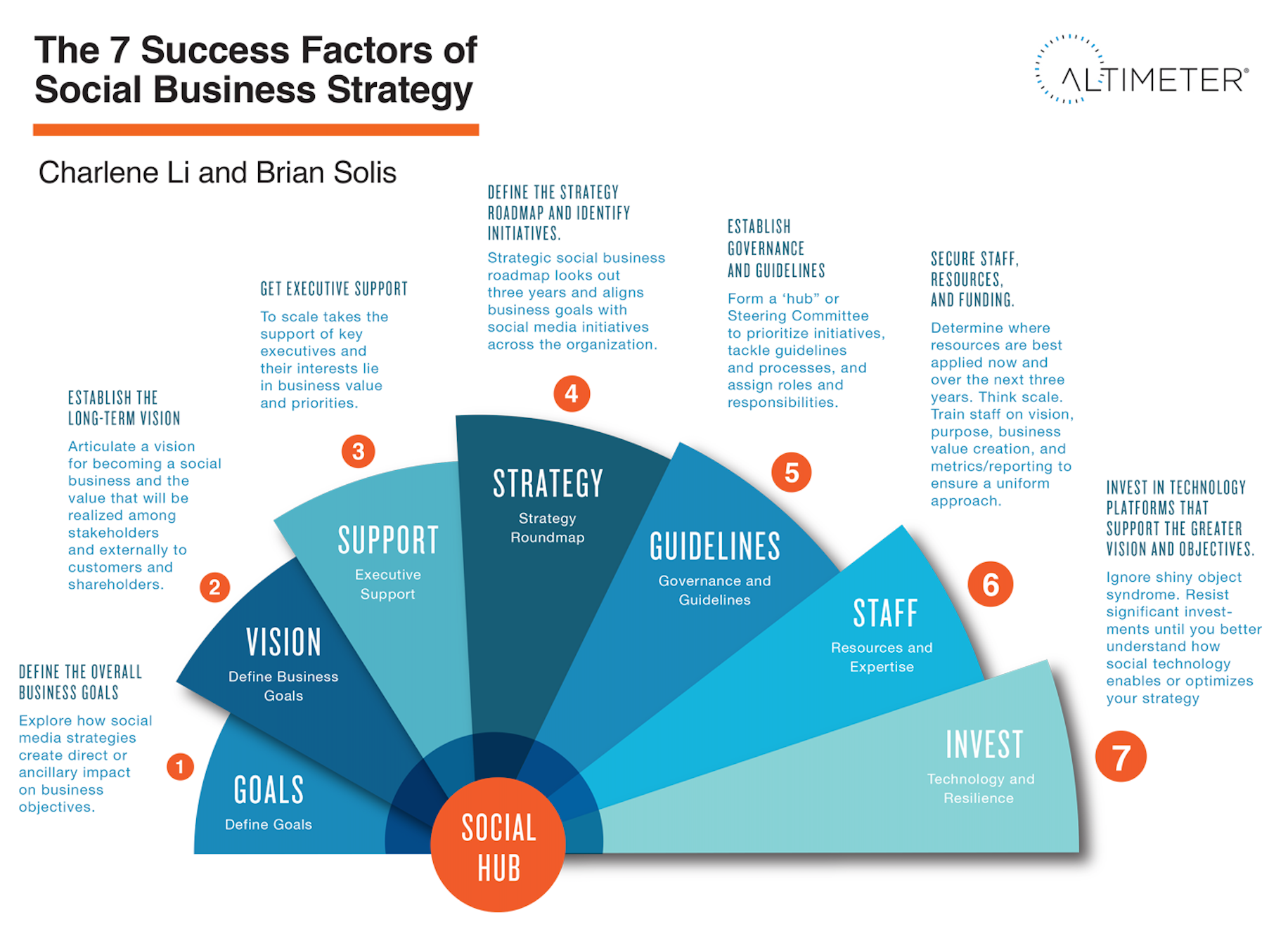Over the years, my partner Charlene Li and I authored a series of research papers and also a short book on the evolution of social businesses, from philosophy to strategy to practice. Along the way, we also produced an effective maturity model and infographic that documented the six stages of social business transformation. This work would eventually pave the way toward my focus on digital transformation and innovation today.
Now, after all this time however, I wanted to share the official infographic from our ebook, The 7 Success Factors of Social Business Strategy.
In our work, Charlene I studied the common attributes of businesses that found success in social. More importantly, we learned how doing so helped the business evolve rigid or traditional models to become resilient. Everything came down to seven stepping-stones that set advanced businesses apart from those meandering or experimenting in social today. You don’t need to read our ebook to learn what they are and why they’re important.
A social business is not a marketing strategy or a technology roadmap but rather a way or philosophy of how business could be done differently…in a much more human manner. Let’s start with Altimeter’s definition of a successful Social Business Strategy (SBS). It is one that aligns with the strategic business goals and has alignment and support throughout the organization. Now, let’s walk through the infographic.
The Seven Success Factors of Social Business Strategy
1. Define the overall business goals.
You can’t align your social strategy with your business objectives if you don’t even know what your objectives are.
2. Establish the long-term vision.
If you’re not striving toward the end goal, you’re likely to veer off the path. If you want your team to fully invest in your social strategy — and you need the support of your entire team – you’ll need to communicate your vision with clarity and passion.
3. Ensure executive support.
In the early days you may be able to fly under the radar, but at some point, if you want to truly have an impact on the business, you’ll need the backing and support of key executives.
4. Define the strategy roadmap.
You already know your business objectives and have a clear vision. But how are you going to get there? Plan out your route, what roads you’ll travel, and what roads you’ll avoid.
5. Establish governance and guidelines.
Who is responsible for executing the social strategy? What’s your process of listening and responding to your customers? If you clearly define this process and then stick to it, you’ll spend less tie floating along throughout the social sphere and more time strategizing your social growth.
6. Secure staff, resources, and funding.
In the early stages of social growth, you might outsource your social media campaign to an agency, and that’s fine. But you should also be looking down the road and planning to develop internal resources to take your company to the next level as your social prowess — and your business — grows.
7. Invest in technology platforms that evolve.
Resist the temptation to jump on the latest technology bandwagon before you have a long-term strategic plan in place. Hold off on making significant technology investments until you’re equipped with a sound vision and strategic plan.
Sure, much of this seems commonsensical. But you and I know that common sense is one of the most uncommon things around. And yes, these seven success factors are true for almost any solid strategy. But by following these seven characteristics of success social businesses, you can and will immediately change course from just another brand, social or digital strategist trying to make sense of social media and instead demonstrating the relationship between business objectives, social technology, and the people in between.
It’s not so much about the terminology as much as it’s about your intentions, the expectations of your connected customers and employees, and how you improve connections, conversations, and experiences to grow your business and the value of the brand.
The image is free to use. Download it from flickr or Slideshare.
As a fun aside, here’s one version of the infographic that didn’t make the cut…
Connect with me… Twitter | LinkedIn | Facebook | Youtube | Instagram | Pinterest








Hi! I like your infographic. There is also a nice acronym: POST.
P like purpose, O like objectives, S like strategy, T like tactic.
Great post Brian. I believe more companies than not feel more a “need to be social” than trying to figure what social can give them if done right. Starting with stating what you wanna accomplish and then building step by step is definitely the way to go.
Thank you Joachim!
Great post Brian and thanks for sharing. Absolutely key if a business is planning to evolve to a Social Business and adapt for the future. This has impact across all the processes in the business plus knowledge sharing. Thanks again.
You’re welcome Joe!
Very interesting, I know a free social media tool very useful, you get Facebook analytics, @smetrica #happymonday
I bought the ebook months ago and I learned a lot, some part very important was when you guys said : When we ask people what their social biz strategy looks like : “Oh yeah we are on Facebook”, Twiiter acct : check, Youtube videos: Yup , Strategic plan: sure, we’ve got a content, metrics, etc,etc. And I love this part : But that isn’t a strategy , It”s a series of tactics masquerading as a master plan!!
Actually I wrote a post on my web ( spanish ) about the book, I will repost again. Gracias Brian!
Saludos!